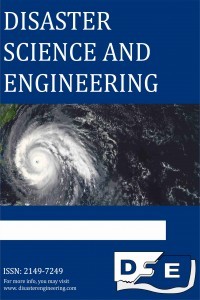Sentinel-1 Uydusu ile Konya Karapınar İlçesi Bölgesel Çökme Analizi
Bölgesel çökme, Sentinel-1, DInSAR, SAR, Uzaktan Algılama
Regional Subsidence Analysis of Konya Karapınar District with Sentinel-1 Satellite
Land subsidence, Sentinel-1, DInSAR, SAR, Remote sensing,
___
- Du, Z., Ge, L., & Ng, A. H. M. (2018, July). Investigation on the Correlation Between the Subsidence Pattern and Land Use in Bandung, Indonesia with Both Sentinel-1/2 and ALOS-2 Satellite Images. In IGARSS 2018-2018 IEEE International Geoscience and Remote Sensing Symposium (pp. 4467-4470). IEEE.
- EARTHDATA, https://www.asf.alaska.edu/sar-data-sets/insar/ [Erişim tarihi: 2016]
- Edalat, A., Khodaparast, M., & Rajabi, A. M. (2019). Detecting Land Subsidence Due to Groundwater Withdrawal in Aliabad Plain, Iran, Using ESA Sentinel-1 Satellite Data. Natural Resources Research, 1-16.
- ESA, https://sentinel.esa.int/web/sentinel/missions/sentinel-1/instrument-payload [Erişim tarihi: 2015]
- Galloway, D. L., Jones, D. R., & Ingebritsen, S. E. (1999). Land subsidence in the United States (Vol. 1182). US Geological Survey.
- GHARECHELOU, S. (2015). Soil moisture retrieval using synthetic aperture radar (SAR) data (Doctoral dissertation, 千葉大学).
- Hsieh, C. S., Shih, T. Y., Hu, J. C., Tung, H., Huang, M. H., & Angelier, J. (2011). Using differential SAR interferometry to map land subsidence: a case study in the Pingtung Plain of SW Taiwan. Natural hazards, 58(3), 1311-1332.
- Hu, L., Dai, K., Xing, C., Li, Z., Tomás, R., Clark, B., ... & Lu, Y. (2019). Land subsidence in Beijing and its relationship with geological faults revealed by Sentinel-1 InSAR observations. International Journal of Applied Earth Observation and Geoinformation, 82, 101886.
- Hürriyet, http://www.hurriyet.com.tr/gundem/konyada-30-yer-coktu-10967526 [Erişim tarihi: 2009]
- Milliyet, http://www.milliyet.com.tr/gundem/konyada-tarla-coktu-yeni-dev-obruk-olustu-2299858 [Erişim tarihi: 2016]
- Sowter, A., Amat, M. B. C., Cigna, F., Marsh, S., Athab, A., & Alshammari, L. (2016). Mexico City land subsidence in 2014–2015 with Sentinel-1 IW TOPS: Results using the Intermittent SBAS (ISBAS) technique. International journal of applied earth observation and geoinformation, 52, 230-242.
- Southern Mongolion Human Rigths Information Center, https://www.smhric.org/news_455.htm [Erişim tarihi: 2002]
- Suganthi, S., Elango, L., & Subramanian, S. K. (2017). Microwave D-InSAR technique for assessment of land subsidence in Kolkata city, India. Arabian Journal of Geosciences, 10(21), 458.
- Üstün, A., Tuşat, E., Yalvaç, S., Özkan, İ., Eren, Y., Özdemir, A., ... & Doğanalp, S. (2015). Land subsidence in Konya Closed Basin and its spatio-temporal detection by GPS and DInSAR. Environmental earth sciences, 73(10), 6691-6703. Xue, Y. Q., Zhang, Y., Ye, S. J., Wu, J. C., & Li, Q. F. (2005). Land subsidence in China. Environmental geology, 48(6), 713-720.
- Ye, S., Xue, Y., Wu, J., Yan, X., & Yu, J. (2016). Progression and mitigation of land subsidence in China. Hydrogeology Journal, 24(3), 685-693.
- Zhou, H., Wang, Y., Yan, S., Li, Y., Liu, X., & Zhang, F. (2018). Monitoring of recent ground surface subsidence in the Cangzhou region by the use of the InSAR time-series technique with multi-orbit Sentinel-1 TOPS imagery. International journal of remote sensing, 39(22), 8113-8128.
- Zhou, L., Guo, J., Hu, J., Li, J., Xu, Y., Pan, Y., & Shi, M. (2017). Wuhan surface subsidence analysis in 2015–2016 based on sentinel-1a data by SBAS-inSAR. Remote Sensing, 9(10), 982.
- Yayın Aralığı: Yılda 2 Sayı
- Başlangıç: 2015
- Yayıncı: Emrah DOĞAN
A Research in Buildings in the Meaning of Fire Safety: The Case of Samsun
Sentinel-1 Uydusu ile Konya Karapınar İlçesi Bölgesel Çökme Analizi
Asena KARSLIOĞLU, Mehmet Hanifi ALKAYIŞ, Kaan KALKAN, Mehmet İnanç ONUR
Tülay EKEMEN KESKİN, Emrah DOĞAN, Osman SÖNMEZ, Hatice Betül UMARUSMAN, Pinar SPOR, Meisam BADFAR, Halil İbrahim ÇETİNER, Packialakshmi S
